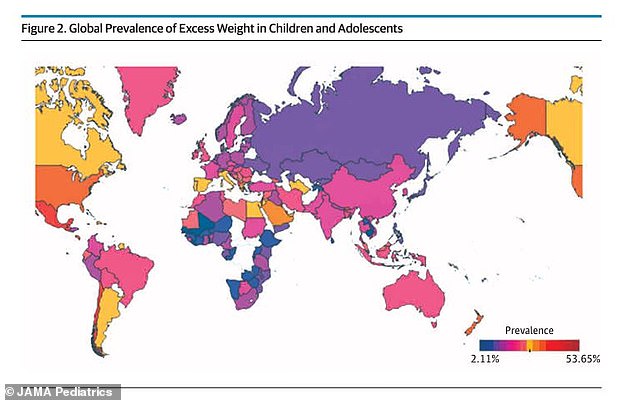A major review suggests that one in five children worldwide is overweight or obese.
In the “most comprehensive study to date,” researchers in China analyzed more than 2,000 studies involving nearly 46 million children and adolescents from more than 150 countries or regions between 2000 and 2023.
Puerto Rico topped the list, with 28 percent of children classified as obese. The US territory was closely followed by the South Pacific islands, French Polynesia (22 percent), the Bahamas (21.3 percent), Kuwait (20.5 percent) and Samoa (19.3 percent).
Meanwhile, the United States scored 18.6 percent, putting it in seventh place on the list. In the UK, 7.6 per cent of children were obese, putting it in the bottom half of countries.
The data only looked at obese children rather than obese or overweight children.
A report from researchers in China found that one in five children worldwide are now considered obese

The highest rates of childhood obesity were found in Puerto Rico, French Polynesia, the Bahamas, Kuwait and Samoa.
However, in Vanuatu, a small island off the eastern coast of Australia, only 0.4 percent of children are obese. It was closely followed by the South Asian country Bhutan (0.5 percent) and Senegal (0.8 percent).
In terms of regions, Polynesia – which encompasses countries such as French Polynesia, Tonga, Somoa and New Zealand – topped the list, with almost 20 per cent of children rated as obese.
The data confirms previous findings suggesting that Polynesian countries have higher obesity rates, although other reports looking at overweight children ranked the United States significantly lower.
Researchers blamed higher obesity rates on diets full of ultra-processed foods, particularly in the U.S. and territories like Puerto Rico.
“European countries and the United States often prefer a diet of processed foods, which are often high in unhealthy fats, added sugars, and refined carbohydrates,” the team wrote.
“In contrast, diets rich in whole grains and vegetables, which are generally considered healthier options, have historically taken priority in Southeast Asian countries.”
In Japan, for example, only four percent of children qualify as obese.
Sedentary lifestyles, skipping breakfast and not getting enough exercise were also theories behind higher rates.
Skipping breakfast has been shown to lead to less satiety throughout the day, which can lead to overeating.
However, the team also noted that mothers who were obese or smoked during pregnancy were more likely to have overweight children.
The findings come after a report warned that deaths from obesity-related diseases such as heart conditions and strokes have increased by 50 percent in the past 20 years.
In the study, the average age of participants was 10 years old and there were almost equal numbers of boys and girls.
Of the 46 million participants, about 4.5 million were diagnosed with obesity, or 8.3 percent.
The team found that high-income countries had an average obesity rate of 9.3 percent, while low-income nations had an obesity rate of 3.6 percent.
They also found that race played a role: Hispanic children were the most likely to be obese and Asian children were the least likely.
As for countries on the lower end of the spectrum, many of them are low-income nations with less food available.
In many countries, such as those in Africa, children are more likely to be active, such as working in agriculture or walking to school and other places.
Limitations of the study included that several countries had limited data and different criteria for defining obesity.
The study was published Monday in JAMA Pediatrics.

